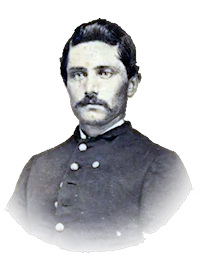Sunday, 6th–The long roll sounded about half-past seven in the morning, and at once we formed a line of battle on the regimental parade ground. At about 8 o’clock we were ordered to the front, and marching out in battle line, about one-half mile, we met the rebels at Water Oaks Pond. Dresser’s battery was just in front of our regiment, we acting as a support to it. The rebels came up on our right, compelling us to fall back about eighty rods to our second position, where we remained until we were again flanked, when we fell back to within about one hundred yards of our parade ground, where we lay down on the brow of a hill awaiting the approach of the rebels in front. While in this position, Thomas Hains of Company E took off his hat, placed it upon his ramrod, and holding it up, shouted to the boys along the line to see what a close call he had had while out in front, for a minie ball had passed through the creased crown of his hat, making four holes. Before he could get his hat back on his head, a small shell burst over us and mortally wounded him.
By this time the rebels were marching right oblique, just in front of us, in double line of battle with their two stands of colors flying. By order we waited until we could look them in the eye and then rose up and fired a volley at close range into their ranks, throwing them into great confusion. We then made a bayonet charge, capturing one of their standards, and together with the Eleventh and the Twentieth Illinois Infantry we captured Cobb’s battery and retook General McClernand’s headquarters. In this charge Company E met its greatest loss of the day.
My musket became so dirty with the cartridge powder, that in loading it the ramrod stuck fast and I could neither get it up nor down, so I put a cap on, elevated the gun and fired it off. But now I had no ramrod, and throwing down my musket, I picked up a Belgian rifle lying at the side of a dead rebel, unstrapped the cartridge box from his body, and advanced to our company, taking my place with the boys. While in this position I witnessed a wonderful sight—thickly-flying musket balls. I have never seen hail falling thicker than the minie balls were flying in the air above us, though too high to do any harm. Our ammunition soon ran out and the entire regiment was ordered to the rear to replenish our cartridge boxes.
When leaving with my company for the rear to restock our ammunition supply, I passed a severely-wounded boy (a stranger to me) who begged me to help him to the rear and out of danger. I stooped down and let him put his arms around my neck, but finding that I could not rise up with him hanging on my neck, I assured him that he would be safe there among the logs, and explained that if I should stay with him, I would surely be taken a prisoner, so left the poor fellow to his fate.
After filling our cartridge boxes, we again formed in line of battle close by the cavalry field and right in the midst of heavy brush timber. Here we remained for about two hours, when we were ordered by General Grant (in person) to a position on the extreme left of the Army of the Tennessee, in support of Dresser’s battery, being placed in line by Webster of General Grant’s staff, just to the left of the siege guns. Here we were engaged for more than two hours. The Fifty-fifth Illinois and the Fifty-fourth Ohio were placed to our left in support of two batteries hard by the river. Here about 5 o’clock in the evening, three regiments of Buell’s army, just arriving, helped to repulse the fearful charge of the rebels.
The Eleventh Iowa was taken from its brigade early in the morning and remained separated all day. Now with the end of the day’s fight, and after dark, we retired a few rods distant from our last line of action and without food or shelter bivouacked for the night, lying down on the wet ground in the rain.
This was our first battle and our company was hard hit, our losses being as follows: Killed, Lieut. John F. Compton, Serg. Ezra McLoney, John R. Buckman, George Croak, Thomas M. Hains and Carlton Frink: mortally wounded. George W. Simmons and John W. Dwiggans; severely wounded, Elmore Chrisman and John T. Rice. [1] About ten other boys were slightly wounded.
[1] Rice finally died on April 19th, from the effects of the wound and typhoid fever.—A. G. D.
